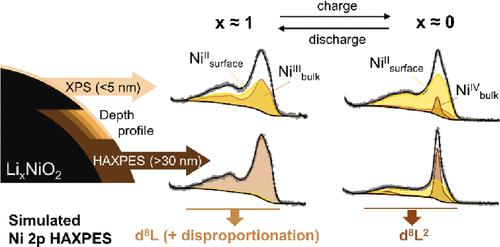当前位置:
X-MOL 学术
›
ACS Energy Lett.
›
论文详情
Our official English website, www.x-mol.net, welcomes your feedback! (Note: you will need to create a separate account there.)
Depth-Resolving the Charge Compensation Mechanism from LiNiO2 to NiO2
ACS Energy Letters ( IF 22.0 ) Pub Date : 2024-03-14 , DOI: 10.1021/acsenergylett.4c00360 Roberto Fantin 1 , Thibaut Jousseaume 2 , Raphael Ramos 1 , Gauthier Lefevre 1 , Ambroise Van Roekeghem 1 , Jean-Pascal Rueff 3 , Anass Benayad 1
ACS Energy Letters ( IF 22.0 ) Pub Date : 2024-03-14 , DOI: 10.1021/acsenergylett.4c00360 Roberto Fantin 1 , Thibaut Jousseaume 2 , Raphael Ramos 1 , Gauthier Lefevre 1 , Ambroise Van Roekeghem 1 , Jean-Pascal Rueff 3 , Anass Benayad 1
Affiliation

|
The performances of lithium-ion batteries depend on the capability of the electrode materials to exchange lithium ions and electrons faster and reversibly. LiNiO2 is a promising electrode candidate for achieving high voltage and capacity. However, its industrialization is hindered by surface and bulk instabilities. These instabilities are due to redox processes involving charge transfer between the cations and anions. Therefore, a fundamental understanding based on further experimental evidence is required to resolve the charge transfer between the cation and anion from the surface to the bulk in LiNiO2. Herein, we resolve the roles of nickel and oxygen in the charge compensation process in LixNiO2 electrodes from the extreme surface down to 30 nm by energy dependent core-level HAXPES supported by an ab initio simulation. We emphasize the central role of oxygen in the bulk charge compensation mechanism from LiNiO2 to NiO2 due to the negative charge transfer and bond/charge disproportionation characters of LiNiO2.
中文翻译:

深度解析从LiNiO2到NiO2的电荷补偿机制
锂离子电池的性能取决于电极材料更快、可逆地交换锂离子和电子的能力。 LiNiO 2是实现高电压和高容量的有前途的电极候选者。然而,其工业化受到表面和体积不稳定性的阻碍。这些不稳定性是由于涉及阳离子和阴离子之间的电荷转移的氧化还原过程造成的。因此,需要基于进一步实验证据的基本理解来解决LiNiO 2中阳离子和阴离子之间从表面到本体的电荷转移。在此,我们通过从头算模拟支持的能量相关核心级 HAXPES 解析了 Li x NiO 2电极从极端表面到 30 nm 的电荷补偿过程中镍和氧的作用。由于LiNiO 2的负电荷转移和键/电荷歧化特性,我们强调了氧在从LiNiO 2到NiO 2 的体电荷补偿机制中的核心作用。
更新日期:2024-03-14
中文翻译:

深度解析从LiNiO2到NiO2的电荷补偿机制
锂离子电池的性能取决于电极材料更快、可逆地交换锂离子和电子的能力。 LiNiO 2是实现高电压和高容量的有前途的电极候选者。然而,其工业化受到表面和体积不稳定性的阻碍。这些不稳定性是由于涉及阳离子和阴离子之间的电荷转移的氧化还原过程造成的。因此,需要基于进一步实验证据的基本理解来解决LiNiO 2中阳离子和阴离子之间从表面到本体的电荷转移。在此,我们通过从头算模拟支持的能量相关核心级 HAXPES 解析了 Li x NiO 2电极从极端表面到 30 nm 的电荷补偿过程中镍和氧的作用。由于LiNiO 2的负电荷转移和键/电荷歧化特性,我们强调了氧在从LiNiO 2到NiO 2 的体电荷补偿机制中的核心作用。



























 京公网安备 11010802027423号
京公网安备 11010802027423号